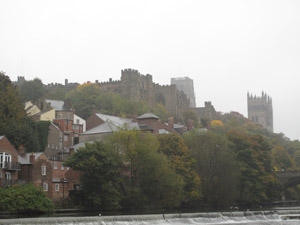Researching the Historic Urban Landscape
The Challenges of the Secular, Religious and Historic Urban Environment
Durham, UK, 26–27 October 2012.

Durham Castle_Oct 12
Expert Meeting organized by the World Heritage Centre and Durham University’s Institute of Medieval and Renaissance Studies (IMRS) and the Centre for the Ethics of Cultural Heritage (CECH), in collaboration with the Institute of Advanced Studies (IAS), as part of the 40th Anniversary of the 1972 World Heritage Convention, with sponsorship from the Durham World Heritage Site authorities and the Netherlands Funds-in-Trust at UNESCO.
Both personal and community identities are formed through landscapes, tangible objects and intangible legacies, and they have become key elements in understanding our past and its associated environment. The key role of heritage and its potential to unite and create a sense of community may also result in conflict and divisions between communities. Tensions, for instance, may arise over who would control stewardship and the benefits of heritage, and how conflicts between different ethnic, religious and national stakeholders should be resolved. These disputes shape and inform the ethical and legal framework of heritage. The meeting focused on the World Heritage site of Durham Castle and Cathedral, which is acknowledged as the largest and finest example of Norman architecture in England, assessing the role of national and international bodies in the legislation, protection, stewardship and promotion of heritage. Given the strong combination of tangible and intangible values that Durham's site accommodates, the meeting appraised the ethical imperatives and difficulties of stewardship, as well as the benefits of cultural and natural heritage conservation.
During the evening of the 26th a keynote lecture was given by Dr. Ron van Oers of WHITRAP Shanghai, outlining a comprehensive research agenda for the Historic Urban Landscape comprising at least nine themes, including the ecological framework, the geological foundation, urban archaeology, urban morphology, climate change, intangible heritage values, socio-demographic change, cities as cultural landscapes, and economic development, which should increase our understanding and valuing of the complex layering, in time and meaning, of dynamic historic urban environments. To kick start the discussion, he put forward the following questions:
• What type of research is needed to increase the understanding of the complex layering of urban areas, embedded values and their meaning for local communities, which can inform management decisions when dealing with change?
• How to use new information and communication technologies to document and present data related to urban heritage conservation, in particular to communicate to other important constituencies in society, such as local communities, the private sector and youth?
• How can this then be used to develop updated methodologies for urban planning, conservation and development, which take the Historic Urban Landscape approach into account?
Annex:  Durham Report Durham Report
|




